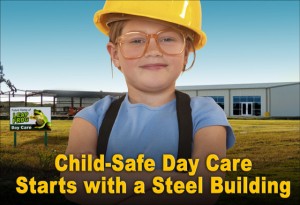The Strongest, Healthiest Childcare Centers Start with Steel
Safety is the number one reason to construct day care centers with steel buildings. The health and well-being of the children and the staff must always be the first priority.
Poor Indoor Air Quality
 Maintaining a healthy indoor air quality (IAQ) cannot be over stressed in any structure, but particularly in a childcare center.
Maintaining a healthy indoor air quality (IAQ) cannot be over stressed in any structure, but particularly in a childcare center.
The EPA (Environmental Protection Agency) considers indoor air quality more critical to overall health than air pollution.
Why?
Because Americans spend almost 22 hours a day indoors. According to an EPA study, indoor pollutants can be 100 times greater than outdoor pollutants.
Poor indoor air quality causes a range of for symptoms often misdiagnosed as colds, flu, allergies, or stress.
“Sick building syndrome” describes any structure chronically causing health problems. According to OSHA (Occupational Safety and Health Administration), if the symptoms disappear when you leave the building, you should suspect the poor IAQ as the culprit.
Most indoor irritants come from inside the building. Wood and wood products, carpeting, glues, pesticides, chemical cleaners, draperies, and other items outgas volatile organic compounds (VOC) into a structure’s air.
Children and the elderly often suffer first from compromised IAQ— especially those with allergies, asthma, or other respiratory problems.
Childhood asthma statistics are frightening.
The Centers for Disease Control and Prevention (CDC) declare asthma is the most common chronic illness in children today. The CDC’s latest figures estimate 6.3 million children in the U.S. now suffer with asthma. Asthma ranks third as the reason for the hospitalization of children under fifteen years of age.
As an inorganic material, steel framing never outgasses or emits VOCs, removing one major source of poor IAQ. Everyone breathes easier in a steel prefab daycare building.
Mold Compromises Indoor Air Quality
Mold is another indoor irritant that sometimes plagues businesses including day care centers.
All mold needs to thrive is moisture and an organic material to feed on. The EPA reports up to 50% of all buildings possess the moist conditions to support mold, bacteria, and other indoor biological pollutants.
Wood products supply the perfect feeding ground for mold. As the fungus spreads, mold spores release into the air to be inhale by anyone in the structure. As with VOCs, children are especially susceptible to illness from mold and fungus.
Avoid potential mold problems by building your businesses or prefab day care buildings with steel.
Inorganic steel never supports fungus, mildew, or mold. Neither does steel hold moisture like wood. Well-constructed steel buildings include many waterproofing features to combat moisture build up within the structure, too.
Termites Feed on Wood
Organic wood has another drawback: termites. Termites feed on wood and paper products.
To thwart the determined wood munchers, the construction industry created chemically treated lumber. Still, termites find their way around the chemical barriers, invading structures.
Wood structures require frequent (and expensive) treatments with harsh chemicals to hold termites at bay. That simply adds to the indoor air problem.
Businesses and day care centers with steel buildings need never worry about termite treatments. Even Formosan termites do not dine on steel.
Fire Loves Wood Buildings
No school or childcare center owner even wants to think about the dangers of fire. Yet according to FEMA (Federal Emergency Management Agency), 4,000 fires occur annually in schools and childcare facilities.
Fire-resistant rigid steel buildings are far less likely to catch fire than wood structures.
For one thing, steel buildings resist damage from lightning.
According to the National Fire Prevention Agency (NFPA), lightning starts an average of 22,000 fires each year.
Since wood is a poor conductor of current, wood-framed structures can explode into flames when struck by lightning. Once the fire starts, the wood framing simply adds fuel to the fire.
As an excellent conductor, steel allows lightning current to pass through it and disperse harmlessly into the ground.
Fire-resistant steel never adds fuel to a structural fire, while wood framing simply feeds a building fire.
More Benefits of Constructing Day Care Centers with Steel Buildings
In addition to the safety features that make pre-engineered metal buildings the ideal choice for childcare structures, RHINO Steel Building Systems offers other benefits for professional prefab day care building operations:
- Cost effective construction and operation
- Clear spans for greater interior design flexibility
- Consistent quality
- Easy expansion as the operation grows
- Energy savings and noise reduction (with Pro-Value Insulation System)
- Faster construction time
- Greater strength, resisting damage from earthquakes, heavy snows, or high winds
- Long lasting value
- Lower insurance premiums with most carriers
- Many accessory and building options
- Superior waterproofing features
- Unlimited exterior building choices
- Very low maintenance
Contact RHINO today at 940.383.9566. Whatever your low-rise commercial or industrial building needs, RHINO has the ideal solution. Call us today to discuss your daycare construction project. We offer free building tips, a free brochure, and a free quote.
Try us just once and you too will be hooked on RHINO! We ship from multiple shipping points all across the U.S., as well as in Mexico and Canada.
